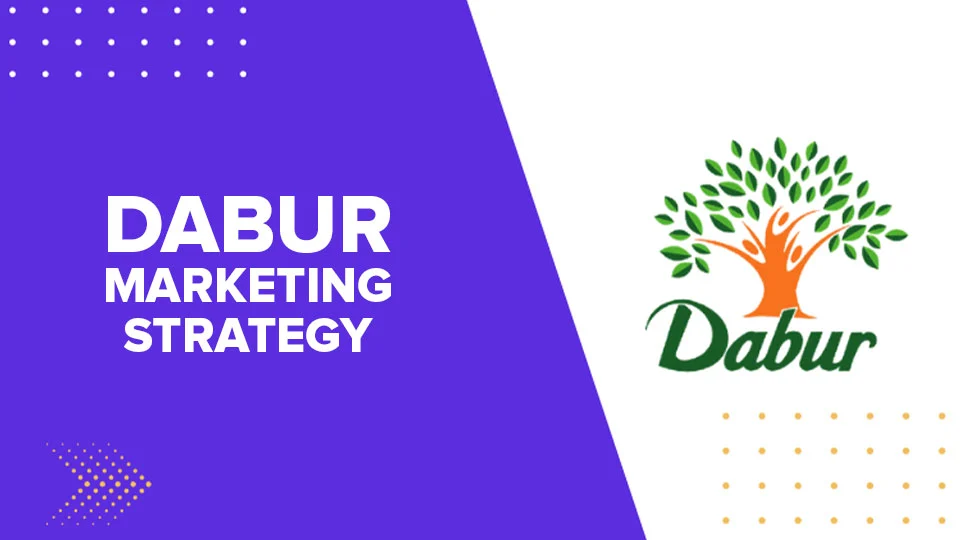Dabur, India’s most trusted brand, has led the FMCG industry with its creative marketing efforts and wide product portfolio. The company, which was founded in 1884, has become a world leader in ayurvedic and natural health products. CMC investigates how Dabur company’s marketing strategy has contributed to its success throughout the years.
With a blend of traditional and contemporary marketing practices, Dabur has developed a powerful brand image. Throughout this blog, different dimensions of Dabur marketing strategy, such as product mix, SWOT analysis, competitors, and advertisement strategies, will be discussed.
Dabur: A Legacy of Over 100 Years
Prior to exploring the marketing strategy, let’s grasp Dabur’s founded from a small pharmacy to an international brand.
Founded in 1884 by Dr. S.K. Burman in Kolkata, Dabur initially dealt in ayurvedic medicines. Presently, it has healthcare, personal care, and food under its portfolio. The company is present in more than 100 countries and reaches millions of consumers.
Key Highlights:
- Founded: 1884
- Headquarters: Ghaziabad, India
- Principal Markets: India, Middle East, Africa, USA
- Principal Product Categories: Healthcare, Personal Care, Foods, Home Care
Dabur’s long history and deep consumer insights have enabled it to establish a robust market position. Let’s discuss how its marketing strategies play a role in its success.
Table of Contents
ToggleDabur’s Product Mix and Product Line
Any company needs a well-defined product mix for its growth. Dabur has a wide product line, serving various customer segments.
Dabur Product Line:
Dabur’s product line is categorized into four broad categories:
| Category | Popular Products |
| Healthcare | Dabur Chyawanprash, Honitus, Hajmola |
| Personal Care | Vatika Hair Oil, Dabur Red Toothpaste, Gulabari |
| Food & Beverages | Real Juice, Homemade Spices |
| Home Care | Odomos, Odonil, Sanifresh |
Product Mix of Dabur:
Dabur adopts a broad product mix strategy, thereby ensuring that it serves different consumer needs. These include:
- Depth: Various product variations (e.g., Real Juice in various flavors).
- Width: Products across various categories.
- Consistency: All of its products fit into Dabur’s mission of natural ingredients and well-being.
Through its varied but well-balanced product portfolio, Dabur becomes a leader in several consumer categories. But how does it promote them? Let’s find out about its advertising and marketing techniques.
Dabur’s Marketing and Advertising Strategies
Marketing is one of the most important aspects for Dabur’s growth and customer base. The company uses a blend of conventional and online advertising to connect with its consumer base.
Major Advertising Strategies:
- Television & Print Ads – Dabur spends significantly on television commercials, which feature Bollywood stars.
- Social Media Campaigns – With more than 10 million followers on social media platforms, Dabur engages with youth consumers through Instagram, YouTube, and Facebook.
- Influencer Marketing – The company partners with fitness and beauty influencers to endorse products.
- Festive & Cultural Promotions – Campaigns such as “Dabur Red Paste – Daanton ka Dum” tap cultural affinity.
- Rural Marketing Initiatives – Dabur’s mobile vans ensure rural reach.
Dabur’s advertisement strategy makes the brand a household name with visibility across urban and rural markets. Now, let’s examine its strengths, weaknesses, opportunities, and threats.
SWOT Analysis of Dabur
SWOT analysis explains to us Dabur’s strengths, weaknesses, opportunities, and threats within the FMCG industry.
1. Dabur’s Strengths
Dabur has established a robust brand image in the FMCG sector with its heritage, trust, and Ayurveda products. These strengths have enabled the company to maintain its market share.
Major Strengths:
- Strong Brand Heritage – Established in 1884, Dabur boasts more than 100 years of trust and credibility.
- Diversified Product Portfolio – Dabur has products in categories such as healthcare, personal care, food, and home care, providing a broad customer base.
- Ayurveda and Herbal Expertise – Dabur has established itself as a market leader in Ayurvedic and herbal products, which is preferred by health-conscious consumers.
- Strong Distribution Network – Dabur products are sold through more than 6 million retail stores in India and exported to more than 100 countries.
- Effective Advertising Strategies – Dabur spends on celebrity endorsements, television commercials, social media, and rural marketing to reach a broad audience.
- Research and Development – Ongoing research in product development keeps Dabur ahead of competitors.
Dabur’s strengths provide it with a competitive advantage over other brands, but it is also faced with some challenges that need to be addressed.
2. Weaknesses of Dabur
Even though Dabur is a market leader, it has certain weaknesses that can affect its growth and market share.
Major Weaknesses:
- Relying on Ayurvedic/Natural Products – Although Ayurveda is a major selling point, it restricts Dabur’s penetration in chemical-based or synthetic product-dominated segments.
- Price Sensitivity – Most Dabur products are costlier than its competitors such as Patanjali, which is price-sensitive in nature.
- Seasonal Demand – Hajmola and Dabur Chyawanprash have fluctuating demand depending on season and trend.
- Limited Market Share in Some Segments – Oral care (as against Colgate) and hair oil (as against Marico’s Parachute) is where Dabur is challenged.
Dabur must increase its product innovation and competitive pricing to overcome these shortcomings and gain a larger market share.
3. Opportunities for Dabur
As the demand for natural and Ayurvedic products is increasing, Dabur has many opportunities to expand and develop its brand.
Major Opportunities:
- Increasing Health & Wellness Trend – People are moving towards natural, organic, and Ayurvedic products, which is in line with Dabur’s brand image.
- International Expansion – Dabur has a good presence in more than 100 countries, but it can expand even more in Europe, the USA, and Southeast Asia.
- E-commerce and Digital Marketing – Online shopping is a buzz, and Dabur can drive sales from Amazon, Flipkart, and its own website.
- Sustainability and Eco-Friendly Packaging – Since consumers tend to choose eco-friendly brands, Dabur can invest in sustainable packaging to appeal to environment-conscious buyers.
- Expansion into New Categories – Dabur can venture into herbal skin care, organic cosmetics, and plant-based nutrition to diversify offerings.
Dabur has huge growth prospects, and leveraging these trends will further consolidate its market position.
4. Threats to Dabur
The FMCG industry is highly competitive and dynamic, and this poses a number of challenges for Dabur.
Major Threats:
- Harsh Competition – Dabur is confronted by stiff competition from Patanjali, Himalaya, HUL, Colgate, and Marico, rendering market retention difficult.
- Unpredictable Raw Material Prices – Dabur depends on natural resources such as herbs and honey, which are vulnerable to climate and price changes.
- Regulatory Issues – The AYUSH Ministry and FSSAI regulations influence Ayurvedic product production and marketing.
- Evolving Consumer Preferences – Consumers are turning to new-age wellness brands and international FMCG brands, threatening Dabur’s dominance.
To offset the threats, Dabur has to remain innovative, be responsive to changing trends, and intensify its competitive advantage.
Key Takeaways of the SWOT Analysis of Dabur
| Factor | Details |
| Strengths | Strong brand recognition, diverse product portfolio, focus on Ayurveda |
| Weaknesses | Dependency on seasonal demand, price-sensitive market |
| Opportunities | Expansion in global markets, increasing demand for herbal products |
| Threats | Competition from Patanjali, Himalaya, and multinational brands |
As Dabur has market leadership, it also needs to innovate continuously to ward off competition as well as establish a stronger international presence.
Dabur vs Competitors: A Market Analysis
Dabur is competing with domestic and international brands across various product segments.
| Competitor | Key Rival Products |
| Patanjali | Herbal Toothpaste, Honey, Juices |
| Himalaya | Skincare, Hair Care, Baby Care |
| HUL (Unilever) | Personal Care, Home Care |
| Colgate-Palmolive | Oral Care Products |
| Marico | Hair Oils, Cooking Oils |
Dabur is competing with traditional brands and new-generation Ayurvedic players. Its emphasis on natural products and brand credibility provides it with a competitive advantage.
Future Plans for Growth and Expansion
Dabur has plans to widen its international outreach and online reach while introducing new herbal and eco-friendly products.
Major Future Plans:
- E-commerce Expansion – Enhanced presence on Dabur website, Amazon, and Flipkart.
- New Launches – Venture into organic cosmetics and immunity-supporting products.
- Sustainability Initiatives – Green packaging and zero-waste production.
- International Growth – USA, Europe, and Southeast Asia target markets.
Dabur’s future plans are towards sustainability and international growth, assuring long-term success.
Final Thoughts: Why Dabur Marketing Strategy Succeeds
Dabur marketing strategy is an ideal mix of heritage, innovation, and digitalization. Its robust product portfolio, in-your-face advertising, and responsiveness have enabled it to maintain leadership in the FMCG industry.
Key Takeaways:
- Varied product portfolio for various segments
- Powerful brand positioning based on Ayurveda and natural wellness
- Successful advertising and digital marketing efforts
- Ongoing innovation to remain competitive
Since CMC examined, the marketing plan of Dabur is an industry standard for FMCG businesses intending to construct a long-term and sustainable platform.
Frequently Asked Questions
What is the central marketing philosophy of Dabur?
Dabur targets Ayurveda, herbal ingredients, and health-oriented brand imagery. It leverages online marketing, rural marketing, and celebrity endorsements to increase its customer base.
Who are Dabur’s key competitors?
Dabur competes with Patanjali, Himalaya, HUL, Colgate, and Marico in healthcare, personal care, and food products.
How does Dabur promote its products?
Dabur employs television commercials, online advertisements, influencer marketing, and print media to market its wide range of products to both urban and rural customers.








